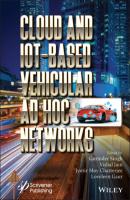Cloud and IoT-Based Vehicular Ad Hoc Networks. Группа авторов
Чтение книги онлайн.

Читать онлайн книгу Cloud and IoT-Based Vehicular Ad Hoc Networks - Группа авторов страница 21
Название: Cloud and IoT-Based Vehicular Ad Hoc Networks
Автор: Группа авторов
Издательство: John Wiley & Sons Limited
Жанр: Автомобили и ПДД
isbn: 9781119761822
isbn:
Table 2.2 illustrates the difference between the routing unit and service unit. Both the routing and service units come under the discovery agents but they differ in the form of processing behavior of an approach, service discovery works on the service line to accomplish the effective services to the users and the route discovery is majorly spotlight on the defining route from vehicle user to the target for smooth transversal between nodes. The two units such as, routing, and service are used for the overall improvement of the framework in the form of operational and conceptual deportment.
The routing unit protocol is distinguished based on their characteristics are Table-Driven Routing Protocol (TDRP), On-Demand Routing Protocol (ODRP), and Hybrid Routing Protocol (HRP) [30]. The definition of routing unit protocols based on their characteristics is as follows:
Figure 2.2 A framework of service discovery.
Table 2.2 Comparison of routing unit and service unit.
| Characteristics | Routing unit | Service unit |
| Protocols | Routing protocols | Service protocols |
| Leaned on | Process-Oriented | Resource-Oriented |
| Discover | Finds the superlative path | Finds the superlative services |
| Parameter for Discovery | Distance, energy, cost, and so on. | Accuracy and efficiency. |
| Mechanism | Route discovery mechanism | Service discovery mechanism |
| Information | Routing information | Service information |
| Layer | Network layer | Network layer |
| Protocols | PUSD, PLSD, and HSD [13–27]. | TDRP, ODRP, and HRP [28]. |
| Reliability | Yes | Yes |
TDRP: This protocol reads the topological information continuously and updates it in the routing table.
ODRP: This protocol reads the topological information when it requires.
HRP: Hybrid uses the features of both TDRP and ODRP.
2.5 Service Discovery Architecture for 5G-VANET Milieu
The few important network characteristics to be considered while designing the service discovery architecture for 5G-VANET are dense, mobility, scalability, collision, failure, congestion, reliability, service availability, and latency. The services provided by the service discovery mechanism are classified into two types such as fixed services and moving services. The definitions of fixed and moving services are as follows:
Fixed Services: The fixed services are the services stored by the service provider in the repository.
Moving services: The moving services are dynamic service. The few examples of moving services are real-time gaming, music sharing, file sharing between two vehicles, and so on.
The service discovery mechanism can be divided into vehicle user side discovery and service provider side discovery. The definition is stated as follows:
2.5.1 Vehicle User Side Discovery
The vehicle user application program does easier as it did not work with the discovery part. Rather, it transmits a request packet to the router. From the router forwards the request to the SP.
2.5.2 Service Provider Side Discovery
The service provider stores the resources (service instances) in the Service Registry (SR). SP checks for the required services in the SR.
2.5.3 Service Instance
The service instances are stored/registered based on two options such as self-pattern and third-party pattern. The self-pattern stores the services by itself. In a third-party pattern the third party stores the services. The service instance changes periodically. For each vehicle user request, the discovery mechanism has to be taken place.
2.5.4 Service Registry
The service registry is a vital component of the service discovery process. It consists of a collection database that stores the service instances.
Figure 2.3 depicts the architecture of service discovery processes for fixed services in the 5G-VANET milieu. The architecture of service discovery processes consists of five components such as human–machine interface display, functional module, context module, non-functional module, and composer. The VANET user enters the request in the human–machine interface display, it’s the functional requirement. The context module gathers the context information from the GPS sensors. The non-functional requirements such as scalability, integrity, cost of service, capacity, security, robustness, and performance are specified by the developers. The composer combines the context information, functional information, and non-functional information and transmits it to the Service Provider (SP). The SP searches for the required resources in the registry and retrieves the optimal services to the VANET users.